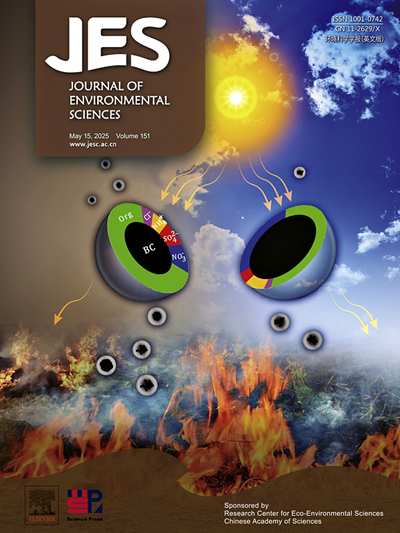土壤活性碳组分和微生物对水田水淹至干枯过程温室气体排放的影响
IF 5.9
2区 环境科学与生态学
Q1 ENVIRONMENTAL SCIENCES
引用次数: 0
摘要
土壤微生物和土壤有机碳(SOC)组分是影响稻田温室气体排放的重要因子。然而,有机肥替代化肥后,土壤中挥发性有机碳组分和微生物对水淹至干燥过程中温室气体排放的影响尚不清楚。本试验采用单施化学肥料(对照)、有机肥替代25%的化学氮肥(NM1)、50%的化学氮肥(NM2)和NM2与作物秸秆配施(NMS) 4种处理进行长期试验。监测温室气体排放,收集土壤样品,测定土壤有机碳组分和微生物。结果表明,从汛期到干旱期,NM2温室气体排放量显著增加了196.88%,主要原因是CO2排放量增加。NMS每kg碳输入的温室气体排放量最低,为9.17。从淹水到干燥,施用有机肥显著提高了土壤的易氧化性有机碳(ROC)含量和碳稳定性;NM2和NMS显著提高了土壤有机碳和不易氧化有机碳(NROC)。不同处理间的细菌群落在淹水过程中存在显著差异,而在干燥过程中只有NMS与其他处理间存在显著差异。从洪涝到干旱,土壤水分条件的变化导致C组分和微生物群落共同影响碳排放,NMS促进了碳固存,减缓了温室气体排放。我们的研究结果强调了水田中与温室气体排放相关的不稳定有机碳组分和微生物的重要性。本文章由计算机程序翻译,如有差异,请以英文原文为准。

Effects of soil labile carbon fractions and microbes on GHG emissions from flooding to drying in paddy fields
Soil microorganisms and labile soil organic carbon (SOC) fractions are essential factors affecting greenhouse gas (GHG) emissions in paddy fields. However, the effects of labile SOC fractions and microorganisms on GHG emissions from flooding to drying after organic fertilizer replacing for chemical fertilizer remain unclear. Here, a long-term experiment was conducted with four treatments: chemical fertilization only (control), organic fertilizer substituting 25 % of chemical N fertilizer (NM1), 50 % of chemical N fertilizer (NM2), and NM2 combined with crop straw (NMS). GHG emissions were monitored, and soil samples were collected to determine labile SOC fractions and microorganisms. Results revealed the GHG emissions in the NM2 significantly increased by 196.88 % from flooding to drying, mainly due to the higher CO2 emissions. The GHG emissions per kg of C input in NMS was the lowest with the value of 9.17. From flooding to drying, organic fertilizer application significantly increased the readily oxidizable organic carbon (ROC) contents and C lability; the NM2 and NMS dramatically increased the SOC and non-readily oxidizable organic carbon (NROC). The bacterial communities showed significant differences among different treatments in the flooding, while the significant difference was only found between the NMS and other treatments in the drying. From flooding to drying, changing soil moisture conditions causes C fractions and microbial communities to jointly affect carbon emissions, and the NMS promoted carbon sequestration and mitigated GHG emissions. Our findings highlight the importance of the labile SOC fractions and microorganisms linked to GHG emissions in paddy fields.
求助全文
通过发布文献求助,成功后即可免费获取论文全文。
去求助
来源期刊

Journal of Environmental Sciences-china
环境科学-环境科学
CiteScore
13.70
自引率
0.00%
发文量
6354
审稿时长
2.6 months
期刊介绍:
The Journal of Environmental Sciences is an international journal started in 1989. The journal is devoted to publish original, peer-reviewed research papers on main aspects of environmental sciences, such as environmental chemistry, environmental biology, ecology, geosciences and environmental physics. Appropriate subjects include basic and applied research on atmospheric, terrestrial and aquatic environments, pollution control and abatement technology, conservation of natural resources, environmental health and toxicology. Announcements of international environmental science meetings and other recent information are also included.
 求助内容:
求助内容: 应助结果提醒方式:
应助结果提醒方式:


